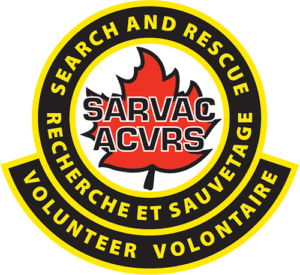
40 Yukon SAR Volunteers met in Whitehorse October 21-23 at the Coast High Country Inn as part of the SARVAC Strengthening the GSAR Role in Canada Project sponsored by Public Safety Canada and the New Initiatives Fund (NIF) from the National Search and Rescue Secretariat.
Over the weekend attendees were met with a hearty schedule of presentations and hands on training sessions including:
- Algoma/SARVAC Insurance Program for SAR – Ryan Bentley, Algoma Insurance
- Communications Games. A discussion on the importance of effective communications, best practices in the field and information on what makes a more compelling rescue story as well as communicating effectively – Cst. Julia Fox and Coralee Reid, Director of Strategic Communications
- CSA National SAR Training Standard. An update on the CSA National SAR Training Standard – Paul Olshefsky, SARVAC Project Manager and retired Parks Canada Safety Specialist and Dog Handler
- Forensic Identification. Forensic Identification in relation to SAR – Vanessa Philpott, Forensic Identification Specialist, RCMP
- El Capitan. Climbing pioneer and long time SAR Volunteer Wayne Merry presented a slide show and Q&A about the first ascent of El Capitan, originally believed to be an almost impossible climb. An epic Chapter in the history of climbing – Wayne Merry
- Incident Command System. ICS is a standardized on-site management system designed to enable effective, efficient incident management by integrating a combination of facilities, equipment personnel, procedures, and communications operating within a common organizational structure – Paul Olshefsky
- Patient Management for the SAR Responder. An overview of current practices when it comes to assessment, management and treatment of patients in the SAR setting. A hands-on workshop encompassing patient packaging, and hypothermia treatment using the latest equipment – Dave Bryan
- Police Dogs and SAR. Covering K9 mission-ready requirements, deployments, search environments, types, and patterns and a review of scenarios. The presentation was great for operational or prospective K9 handlers, it may also be of interest to search managers, team leaders and searchers who work with K9 units – Cpl. Cameron Long, RCMP
- Post Mortem Changes and Considerations. An overview of drowning, hypothermia, and animal interference. The basics of post-mortem changes following death and considerations to make when human remains are located – Kirsten MacDonald, Yukon Chief Coroner
- Rescued! A look from the other side, retired RCMP Corporal Ken Putnam provides his own account of being the subject of a search after he fell 100 feet into a crevasse, dislocating and fracturing his shoulder. He was rescued 12 hours later!
- River Rescue. Focus on hazards to rescuers – Kevin Daffe, Tatshenshini Expediting
- Rope Rescue. A practical session including low angle rope rescue rigging. Discussion of one or two rope systems and when each would be required and finally the difference between load sharing rope systems vs. traditional main and belay systems – Jason Wolsky, Technical Rope Rescue Specialist, Raven Rescue
- Wildlife Encounters. Considerations regarding potential encounters with dangerous wildlife as well as searcher safety and scene preservation in the event of a discovery of a wildlife attack victim – Conservation Officer Aaron Koss-Young
Many thanks to those who attended and made our latest stop on this project a success. Next up is New Brunswick!
